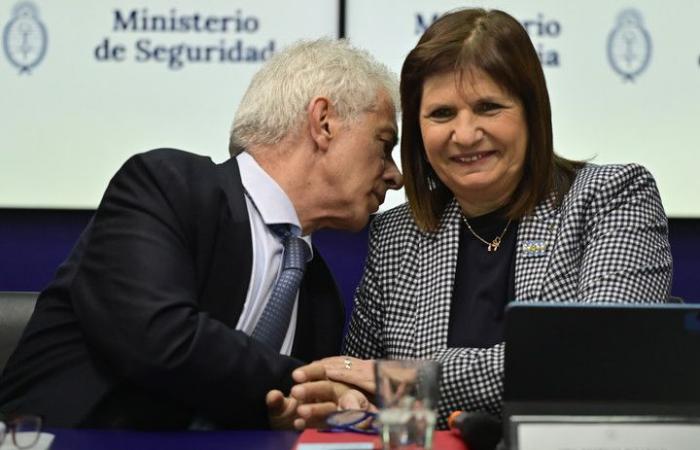After the approval of the Base Law, the Government presented this Friday the draft Juvenile Criminal Law. The Minister of National Security, Patricia Bullrich, and the Minister of Justice, Mariano Cúneo Libarona, anticipated in a press conference the reform that the libertarian administration of Javier Milei will send to Congress to combat crime by minors.
Technically it is called “Juvenile Penal Regime”. Indicate what is the penalty of imputability and establishes a series of organizing measures of the Penal Code according to the crime committed.
In the summary of the text of the project, which was accessed Clarionwe start with the strongest: the ages. “Adolescents between 13 and 18 years old“.
It details that minors between those ages who commit crimes may be deprived of their liberty in “special establishments or separate sections of penitentiary establishments, under the direction of qualified personnel” and that their parents must be informed of the accusation and the procedural acts.
“The judge and the Public Prosecutor’s Office will ensure at all times the effective protection of the rights of the victims,” it states.
If it is imposed suspended sentencecomplementary measures must be applied jointly, such as “attendance at educational programs, civic training, job training, attendance at health services, medical or psychological treatmentobligation to search for and, if possible, obtain a jobattendance at court, prohibition of the consumption of alcoholic beverages and narcotics”.
As for the penalties, they will be 3 to 6 years in prison “as long as there has been no death of the victim, no serious physical or psychological violence on people, there are no very serious injuries in culpable crimes and no other processes or convictions are registered.”
The penalty may be replaced by a warningprohibition of approaching the victim or their family members, prohibition of driving vehicles, of attending certain places (such as entertainment or sports establishments), prohibition of leaving the country or a territorial area, provision of community services or electronic monitoring.
Compliance with sentences must be verified by judges or prosecutors. “Also for the victim, if that is their wish”it is clarified.
The maximum sentence that the accused can receive will be 20 years. Upon serving 2/3 of the sentence, the court may order that some of the alternative measures be continued. In the event of non-compliance, it will be replaced by a more severe one.
The lowering of the age of imputability
“In cases of non-attributable minors (those under 13 years of age), the judge will still will investigate the existence and circumstances of an illegal act and the alleged intervention of third parties. In these cases, the judge will carry out a psychological assessment, an environmental report, and involve other agencies. Given the risk that the minor may commit new crimes, he may also order his institutionalization for social rehabilitation,” it is explained.
In this way, the Government’s plan to lower the threshold of criminal responsibility by three years, which is currently from 16 years of age, to 13, was officially established.
The prosecutor may dispense “totally or partially with criminal action If the crime carries a penalty of less than six (6) years and there are no other circumstances, such as the death of the victim, very serious injuries, existence of other proceedings.”
When the crime has a sentence of less than 6 years, a criminal mediation process with the victim or his/her representatives. Under the conditions provided for all cases, for sentences not exceeding three years, access to the probationIf the conditions are not met, the judge will order that the process continue without counting the time elapsed.
“Once it enters and is part of the Penal Code, each of the districts will adapt it to their procedural codes; “They must define what type of holding places they are going to use for minors,” Bullrich had explained in May about how it would be applied.
At that time, he assured that not all provinces have the same situation, and that for that reason each one must define where it will house juvenile offenders.
“We have provinces that have two minors (offenders), so you cannot create a large structure, there are others that have more,” he said.
Bullrich had also advanced the changes he would propose in the Trafficking Law for minors. For this, he gave as an example those cases in which adults force or pay teenagers to commit a crime.
“We are going to introduce a change to consider minors who are hired or placed with a gun to their head to go out to kill or commit crimes as a form of trafficking. Because the person who carried out the hiring of that minor has as much or more responsibility than the minor,” she assured.
“We are seeing it with foreigners, who come with minors, or with criminal organizations. This interpretation will be very important for minors to inform which organization (that hired them) was, the official added.
Today, the juvenile penal regime applies to young people between 16 and 18 years old. These adolescents may be deprived of their liberty in specialized institutes called Centers for the Reception and Containment of Minors. They are punishable, that is, they are responsible for crimes with prison sentences of more than 2 years.
It is not the same adult justice, but they are being tried in that specialized system. Those under 16 are not punishable today.
 Patricia Bullrich presents the Juvenile Penal Law Project together with Mariano Cúneo Libarona. Photo: Matias Martin Campaya
Patricia Bullrich presents the Juvenile Penal Law Project together with Mariano Cúneo Libarona. Photo: Matias Martin Campaya According to the National Survey of Juvenile Penal Devices and their Population of the Secretariat of Children, Adolescents and Family, in the first half of last year there were 2,407 minors in specialized detention centers, of which 1,022 were under 16 years old.
“Unfortunately, of the total number of adolescents not punishable in juvenile criminal devices (44), 56.8% are in devices of deprivation and/or restriction of freedom in different jurisdictions of the country (12 and 13 cases respectively), seriously affecting the rights of boys, girls and adolescents protected by current national legislation. Therefore, it is considered a priority to combine efforts and resources to prevent the entry and permanence of non-punishable adolescents in juvenile penal systems,” says that report.
1% of serious crimes (including homicides) are committed by minors under 16 in Argentina, and Life imprisonment is prohibited in the country for offenders under 18 years of age..








